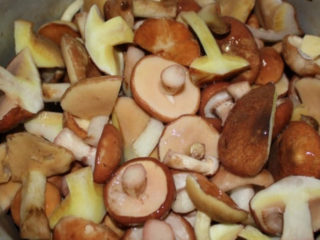Content
Often, when preparing dishes from boletus, an unpleasant situation may arise due to the fact that the boletus turns pink during cooking. This does not frighten experienced mushroom pickers at all, but beginners may be wary and even refuse to eat their favorite delicacy of mushrooms. Next, we will consider what causes this phenomenon, whether it is dangerous, and how it can be dealt with.
Why do boletus turn pink when cooked?
There are few reasons why fruiting bodies change their color; if the butter dish turns pink during cooking, most likely the species composition of the contents of the pan, kettle or cauldron included more than just representatives of this species.
Other mushrooms are the first reason why boletus turns red or pink when cooked
Oilseeds are unique representatives of the mushroom kingdom - this is perhaps the only genus that does not have poisonous false counterparts. That is, there are many varieties whose fruiting bodies are similar to them, and these closely related species are very easy to confuse.
The substances that make up such twins are capable of changing the color of the fruiting bodies during heat treatment.And since the chemical composition of these species, as well as all representatives of the Boletaceae family, is the same, and they are all boiled in the same container, then, naturally, everything is colored, regardless of species.
Should I be concerned if the butter turns pink during cooking?
There is no reason to panic if the boletus turns pink after cooking, and besides, the taste of the dish will not even change. Almost all of their counterparts are edible and have similar physiology and, therefore, taste characteristics.
Of course, many will not like the color of pink or purple fruiting bodies in a dish, but this is not so critical, in addition, you can always use some kind of sauce or gravy to change the color scheme of the dish.
How to cook boletus without turning pink or red
To ensure that the fruiting bodies do not change color during heat treatment, you should carefully consider the preliminary preparation of the harvested crop for cooking. It is necessary to carefully examine the fruiting bodies before heat treatment and identify undesirable species among them:
- reshetnikov, from which boletus turns pink when cooked;
- Mokhovikov, leading to butternuts turning red during cooking;
- Kozlyakov, which make the neighbors in the pan purple.
It is relatively difficult to distinguish these species from each other, but it is possible. Kozlyaks, unlike many Boletovs, do not have a skirt. The lattice has a cap of smaller diameter with a pronounced tubercle in the middle.The flywheel has a thicker cap.
If all checks have been passed, but you want additional guarantee that the color of the dish will not change, it is recommended to add 0.2 g of citric acid per 1 liter or 15 ml of 6% vinegar to the same volume of water during cooking.
Conclusion
If the butternuts turn pink during cooking, there is no reason to worry. A similar phenomenon is caused by the appearance of other mushrooms in the total mass of the prepared dish. Since all counterparts of the species in question are edible, such food does not pose any danger. All possible mushrooms (similar to Butteraceae) that cause these color changes belong to the Boletaceae family and have similar taste characteristics. The unusual color of the dish will cause some inconvenience, but this can be corrected by adding additional seasonings to it.












